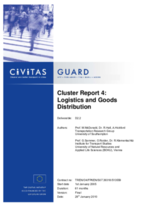New approaches to integrated planning: Ahoy-Zuidplein
Summary
The measure was designed to demonstrate the benefits of integrated approaches to urban planning at traffic and transport nodes at three city centre locations.
Implementing sustainable mobility
The development of public areas combining several functions has been addressed in several policy documents, in particular the Rotterdam Plan for Spatial Development. This measure developed a new approach to integrated planning for three strategic transport interchanges: Alexander, Kralingse Zoom and Ahoy-Zuidplein.
The focus for the Ahoy-Zuidplein site was on producing an integrated design study for the Ahoy leisure and sports centre and Zuidplein metro/bus station and shopping centre, improving accessibility and ensuring smart land use.
Progress
In the Ahoy-Zuidplein area, a report was completed in 2003 on preconditions for development, on the basis of which the local government decided that the bus station should be the first project to be undertaken, as it was the weakest link in terms of the appearance and safety of the project area. In 2004, the city council decided to approach the area with individual projects rather than an integrated master plan.
In 2005 a design study was undertaken for the bus station and surroundings, commissioned by the local and the regional government. This study estimated the requirements for and cost of a new integrated bus station so that a decision could be made. Also in 2005 a study was undertaken to analyse different models for the future of the leisure centre and its integration in a renewed Zuidplein area. The study covered traffic and parking solutions, spatial models, and costs and benefits.
Outcomes
Cooperation between government and private partners proved to be an important driver for the acceptance of the project. However, the actual implementation of the integrated planning processes requires several years and lies well outside the scope of the TELLUS project. In general, it is not easy to assess the impact of “soft measures”: while they may, for example, be aimed at improving traffic conditions by reducing congestion, it is not possible to relate actual impacts with the measure of integrated planning. In the case of Ahoy-Zuidplein, safety was shown to have improved following the renewal of the bus station, but it is difficult to argue that the improvement was due to an integrated approach to planning rather than to the individual project. Nevertheless, one positive impact of the measure was the fact that all stakeholders were involved in the long-term planning, contributing to smoothing the complex processes.
The magnitude of such projects implies serious financial risks, thus private enterprises willing to take such risks can be the most important project drivers, as in the case of the Ahoy-Zuidplein area. If pressure from the private market is sufficiently strong, policy makers will usually create the preconditions for new developments.








